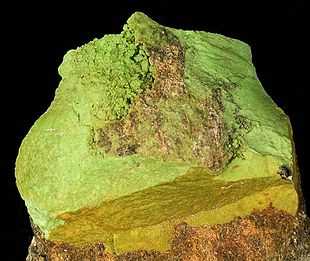Gaspeite
| Gaspeite | |
|---|---|
 Gaspeite | |
| General | |
| Category | Carbonate mineral |
| Formula (repeating unit) | (Ni,Fe,Mg)CO3 |
| Strunz classification | 05.AB.05 |
| Dana classification | 14.01.01.08 Calcite group |
| Identification | |
| Color | Pale green to light grass green |
| Crystal habit | Rhombic crystal aggregates, nodular concretions, massive |
| Crystal system | Trigonal - Hexagonal Scalenohedral H-M Symbol (32/m) Space Group: R 3c |
| Cleavage | {1011} Good |
| Fracture | Uneven |
| Mohs scale hardness | 4.5 - 5 |
| Luster | Vitreous to dull |
| Streak | Yellow green |
| Diaphaneity | Translucnt |
| Specific gravity | 3.71 |
| Optical properties | Uniaxial (-) |
| Refractive index | nω = 1.830 nε = 1.610 |
| Birefringence | δ = 0.220 |
| References | [1][2][3] |
Gaspeite is an extremely rare nickel carbonate mineral named for the place it was first described, in the Gaspé Peninsula, Canada.
Gaspeite's formula is (Ni,Fe,Mg)CO3 and it is a bright green mineral. It forms massive to reniform pappillary aggregates in fractures, bottryoidal concretions in laterite or fracture infill. It is also present as stains and patinas on iron oxide boxworks of gossanous material.
Paragenesis
Gaspeite is formed in the regolith as a supergene alteration mineral of nickel sulfide minerals, generally in arid or semi-arid environments which produce conditions amenable to concentration of calcareous or carbonate minerals in the weathering profile.
Gaspeite from Widgiemooltha is associated with talc carbonated komatiite-associated nickel sulfide gossans and is probably formed by substitution of nickel into carbonates such as magnesite which are formed by oxidation of the talc-carbonate lithology, and of primary and supergene nickel sulfide minerals.
Gaspeite is formed from a similar process to the weathering of other sulfide minerals to form carbonate minerals. The sulfide minerals which are weathered to produce gaspeite are pentlandite, violarite, millerite and rarely nickeline.
Occurrence
Gaspeite is known from a handful of locations worldwide. Aside from its type locality in Canada, gaspeite is found in the nickeliferous gossans of Kambalda type komatiitic nickel ore deposits in Kambalda, and nearby Widgie Townsite, Widgiemooltha, both south of Kalgoorlie, Western Australia, in both locations also associated with garnierite and kambaldaite.
Nickel carbonate, though not conclusively proven to be gaspeite, is also reported in hydrothermally altered ultramafic rocks in New South Wales, Australia, associated with serpentinite bodies and lode gold deposits.
Gaspeite is reported from the Lord Brassey Mine, Tasmania, in association with hellyerite.
References
- ↑ http://www.handbookofmineralogy.com/pdfs/gaspeite.pdf Handbook of Mineralogy
- ↑ http://www.mindat.org/min-1657.html Mindat.org
- ↑ http://www.webmineral.com/data/Gaspeite.shtml Webmineral data
- Thornber, M. R. (1975a) Supergene alteration of sulphides, I. A chemical model based on massive nickel sulphide deposits at Kambalda, Western Australia. Chemical Geology, 15, 1-14.
- Thornber, M. R. (1975b) Supergene alteration of sulphides, II. A chemical study of the Kambalda nickel deposits. Chemical Geology, 151 117-144.
- Thornber, M. R.; Nickel, E. H. (1976). "Supergene alteration of sulphides, III. The composition of associated carbonates". Chemical Geology 17,: 45–72.